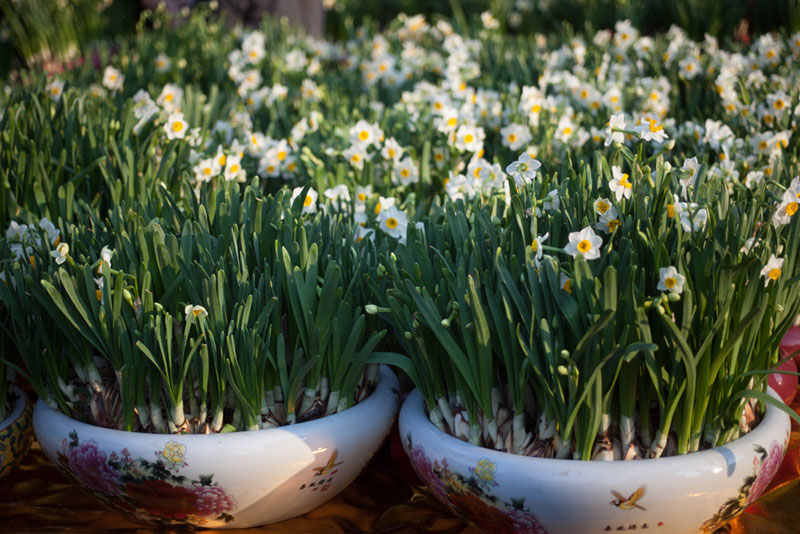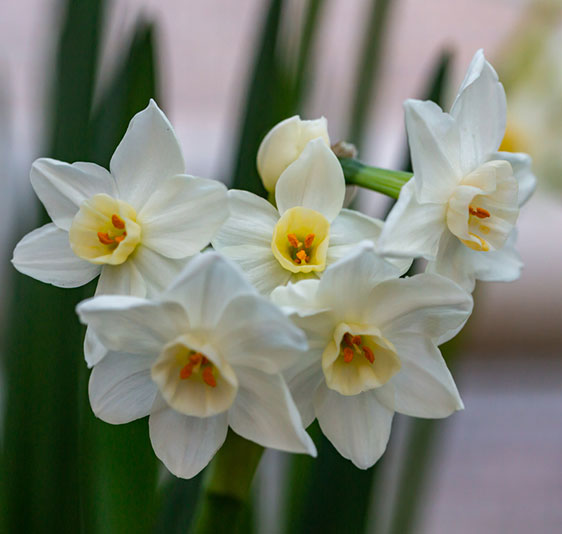
The paperwhite narcissus is a houseplant that is typically used to brighten up a home during the winter months. It is native to the Mediterranean, and it produces white blooms that resemble daffodils.
The blooms are white in color, and each stem will grow four to eight flowers at a time. Since the plant prefers warm temperatures, it can be found in hardiness zones eight through 10.
These plants are fairly simple to care for, but let’s take a look at some growing tips that will help you before you decide to grow one in your home.
Light and Temperature Requirements
This plant does well in full to partial sunlight, so keep that in mind if you are growing it outdoors. Since this is a plant that is commonly grown indoors, it is important to make sure that it gets direct sunlight that is pretty bright so that it grows with ease. Ideally, you don’t want the plant to grow more than three feet from a window or a light source if possible. Temperatures for this plant should be between 60 and 70 degrees Fahrenheit during the day. At night, the temperature can be a little cooler that is about 50 degrees or so, but it will not be able to grow in freezing temperatures.
Water Requirements
An average amount of water is all this plant needs to grow, so you will only need to provide it with water about once every week or so. If the soil is still wet, then don’t water it right away. You want the soil to be somewhat dry before giving it more water so that the roots don’t become too moist.
Soil and Fertilizer Requirements
The paperwhite narcissus needs well-draining soil to grow, but it is not very picky about the type of soil that it grows in. Soil that is rich in nutrients from leaf litter or organic compost is a great idea for the plant to thrive. If you are going to force the plant to bloom, then using a high in phosphorous fertilizer will help encourage more growth and bigger blooms. Once the plant blooms, it will not bloom again if grown indoors.
Deadheading and Pruning
With paperwhite narcissus, you won’t have to do much deadheading, but if you wish to prune, cut the stalks off at the base when the blooms start to wither. Usually, you can tell this is happening when they begin to turn brown on the petals. Once the leaves themselves start to wilt, you can also cut them off at the junction where they meet the body of the plant so that the stem remains intact.

Growing from a Seed
The plant can be grown three different ways indoors, which include in water, pebbles, or soil. The planting should be done in the fall, and it does not require a chilling period before it’s planted. This process will allow it to bloom in the spring without much effort. If you are forcing the plant to bloom, it needs to be planted about four to six weeks before you want it to bloom.
If grown in pebbles, you will want to use a container that has tall sides. I suggest something clear that allows you to keep an eye on the roots as they grow. Put pebbles in the bottom of the container. Add water so that the pebbles are covered, and then place the bulb on the pebbles. The bulb will need to be placed in a sunny location to grow. Ensure that the pebbles stay covered in water, but the bulb is always above the water with the pointy side away from the water.
If using soil, the container should be shallower. Fill a 6-inch container about 1/3 of the way with soil and plant the bulb to slightly peeks out of the soil. Ensure the plant gets plenty of sun, and the soil stays moist as it begins to grow.
Concerns to Consider
One of the primary concerns about the paperwhite is its status as an irritant; wear gloves while dealing with this plant, and if you’re growing it indoors, keep it out of the range of pets. When ingested by our furry friends, the plant is toxic, so plant it high in a place where a dog or cat can’t easily get to the leaves. These plants contain lycorine, which will trigger vomiting in animals.
Paperwhites also tend to get leggy; to avoid this, ensure that they get enough light and ensure that the room is cool enough. Ideally, an environment that’s around 60 to 70 degrees Fahrenheit should help them grow correctly.




